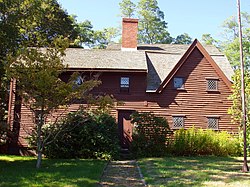John Balch House
John Balch House | |
 John Balch House, Beverly, Massachusetts. | |
| Location | 448 Cabot St. Beverly, Massachusetts |
|---|---|
| NRHP reference No. | 73000275 |
| Added to NRHP | February 23, 1973 |
The John Balch House (circa 1679, but for many years was purported to have been built in 1636), located at 448 Cabot Street, Beverly, Massachusetts, is one of the oldest wood-frame houses in the United States. It is now operated as one of the historic house museums of the Beverly Historical Society, and open from June through October.
According to the Beverly Historical Society,[1] the house was built from timbers harvested in 1678/1679. "... the entire northern end of the Balch House was most likely constructed during 1679."
History
John Balch gained title to the land on November 11, 1635, through the "Thousand Acre Grant" and apparently was living on this property by 1636. This was the date assigned to the house by the Beverly Historic Society, but the date was based exclusively on the historical record. Architectural historians, including Abbott Lowell Cummings, the leading expert on early New England architecture, were only sure that the Balch House was a seventeenth-century house.
Historians Abbott Lowell Cummings and Gary Wheeler Stone dated the "new" section to about 1700, but dendrochronology has provided the date of 1679.[2] Cummings has stated emphatically his faith in the dendrochronology work being done in Massachusetts.
The house remained within the Balch family until 1916, though with periods of tenant rental. It was then acquired by the Balch Family Association.[3] They hired Norman Isham, a popular preservation architect, to evaluate the house. After finding original rafters in the attic, he recommended that the back lean-to be ripped off and the southern half of the house be dismantled. This plan was eventually modified to expose and recreate the roofline of the original story and a half structure. Thus today's house has been heavily shaped by intentional restoration. In 1932, the home was turned over to the Beverly Historical Society,[4] which maintains and operates it today.
See also
- National Register of Historic Places listings in Essex County, Massachusetts
- List of the oldest buildings in Massachusetts
References
- ^ http://www.beverlyhistory.org/200704smnews.pdf Beverly Historical Society Spring 2007 newsletter
- ^ Paul Leighton, Tests cast doubt on Balch House's 'oldest' claim, The Salem News online, April 25, 2007. Accessed online 2009-11-09.
- ^ Lapham, Alice Gertrude (1930 reprt.) Old Planters of Beverly in Massachusetts and the Thousand Acre Grant of 1635, p. 96. Applewood Books.
- ^ Beverly Historical Society (2010). Beverly Revisited, p. 127. Arcadia Publishing.
External links
- Beverly Historic Society & Museum
- The Balch House
- Salem News, April 25, 2007 (dendochronoly supports 1679 dating)
42°33′44″N 70°53′3.8″W / 42.56222°N 70.884389°W

